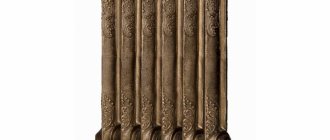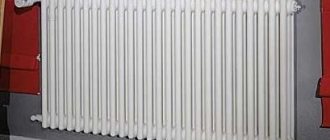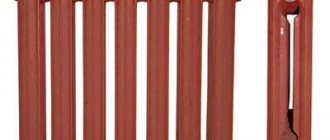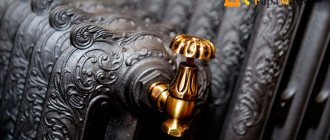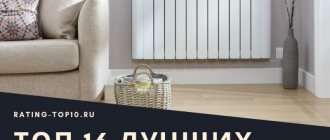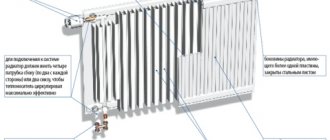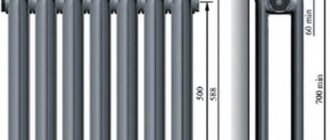Rating of the TOP 10 best cast iron heating radiators of 2020
| Place | Name | Price |
| TOP 10 best cast iron radiators in price/quality ratio | ||
| 1 | STI Nova 500 | Find out the price |
| 2 | Konner Modern 500 | Find out the price |
| 3 | Viadrus Styl 500/130 | Find out the price |
| 4 | RETROstyle TOULON 500/110 | Find out the price |
| 5 | STI Nova 300 | Find out the price |
| 6 | RETROstyle WINDSOR 500 | Find out the price |
| 7 | Viadrus Bohemia R 450/225 | Find out the price |
| 8 | Konner Modern 300 | Find out the price |
| 9 | Viadrus Bohemia 450/220 | Find out the price |
| 10 | Demir Dokum Floral 750 | Find out the price |
How to choose and what to pay attention to?
To choose an effective and reliable model, you should know some of the nuances of cast iron radiators.
- If your room has a standard ceiling height, a power of 120 W per sq.m. will be sufficient.
- Each section weighs from 3 to 7 kg. After installing the battery, the quantity can be increased or decreased.
- The standard location of batteries is wall-mounted, but floor-mounted ones are also available. For wall-mounted ones, you need to choose a strong bracket or hooks; for floor-mounted ones, “legs” are provided.
- The old type of model holds one and a half liters of coolant, the new ones have less of it - up to 0.8 liters.
- The old ones have a pressure of 8 atmospheres, the new ones - 12-18 atm.
Batteries should not be repainted frequently. Each layer of paint reduces heat transfer.
Which radiators are better: cast iron or steel?
Modern heating batteries are made from non-ferrous metal alloys, which increases their heat transfer, service life and improves other parameters. However, such products are expensive. More often, when arranging heating, a person is faced with choosing one of two types of available radiators - cast iron and steel.
Cast iron and steel radiators are the most affordable for home heating
To choose the optimal model, you need to compare batteries made from these materials. Steel and cast iron differ in their properties, which affects the performance characteristics of the finished product.
First of all, the following parameters are considered:
- dimensions and weight;
- design, the ability to choose different forms of execution;
- ease of installation;
- duration of operation in a specific heating system;
- heating rate, output and duration of heat retention;
- mechanical strength.
In terms of the first parameter, cast iron products lose. Radiators are heavier and larger in size. In theory, a steel product should be heavier, since the material has greater density. However, this further increases its strength. To achieve equivalent performance, cast iron sections are cast of greater thickness. Naturally, they increase in size and weight.
If you do not take into account the old Soviet models, the design of modern cast iron radiators is not inferior to their metal counterparts. However, the choice of forms is still smaller. The problem is related to the complexity of producing cast iron products for heating.
There are also disadvantages to the ease of installation. Due to their heavy weight, cast iron heating devices require reinforced fasteners. If the apartment has a false wall made of plasterboard, then installing heating will bring more problems. You will have to build stands under cast iron radiators, which do not look aesthetically pleasing.
Advice! If the walls do not allow brackets to be used for fastening, it is optimal to choose cast-iron radiators with imported legs for heating. They are installed on the floor, like a regular heater.
A cast iron battery is more difficult to mount on the wall; in addition, an ugly bracket often remains visible
As for the duration of operation, it is necessary to consider specific heating conditions and parameters. Cast iron is resistant to the aggressive effects of any coolant composition and is not destroyed by contact with oxygen. Steel loses in this regard, but gains in strength. Cast iron sections are destroyed by mechanical stress, for example, an accidental impact or when a radiator falls. Cracks can appear when water hammer occurs in the heating system. Under normal operating conditions, steel radiators will last up to 25 years, and cast iron radiators - up to 40 years.
The rate of heating, output and duration of heat retention by the radiator determines the heating efficiency. Here we need to consider a specific case. In modern apartments, heating is installed with temperature control for each room. It is important here that the radiators quickly heat up, give off heat and cool down. In this regard, metal models benefit from automated heating. Cast iron heats up more slowly than steel, which requires more energy consumption, but retains heat longer. It is better to install such batteries on country heating, where it is rarely turned on. After a single “run” of the system, cast iron will retain heat for a long time.
Drawing specific conclusions on the considered parameters, it is optimal to choose steel radiators for modern heating. They warm up the room faster, resulting in less energy consumption. The advantage is light weight, ease of installation, attractive design, resistance to water hammer and mechanical stress.
The video shows a comparison of the heating of a cast iron and steel radiator:
The best cast iron radiators in price/quality ratio
STI Nova 500
Radiator made of lightweight cast iron with good functionality . The maximum number of attached sections is 14.
Warm up quickly with a circulation pump. The heat dissipation is excellent. Connection diameter is 1 inch.
Fuel in the section - no more than 0.52 liters . The distance between the axles is 500 mm. Pressure - 18 bar (pressure testing) and 12 bar (working).
The heat output of the radiator is 120-1680 W. Connection - side.
The outer part is spray painted and pre-treated with a sandblasting machine..
You can install a regulating tap for water supply to the radiator (this will help you regulate the heat yourself using the tap).
Specifications:
- section weight: 4.2 kg;
- section dimensions: 60 mm (width);
- thickness: 85 mm;
- height: 580 mm.
pros
- strength;
- price;
- aesthetic appearance;
- compactness.
Minuses
- narrow passage opening;
- the paint chips easily.
Konner Modern 500
The line of these radiators is very popular and has many positive reviews for several reasons.
Firstly, all models are adapted to Russian operating conditions, secondly, they have high heat transfer, and thirdly, they are easy to install (without the involvement of unauthorized persons) and maintained.
They comply with GOST requirements, as well as international production quality standards.
Quality guarantee - 5 years, service life - 5 times longer. The inlet diameter is 32 mm.
Heat dissipation - 130 W. The test pressure parameters are 1.8 MPa, and the working pressure is 1.3 MPa. The distance between axles is 500 mm.
Specifications:
- section without nipple weighs: 4.14 kg;
- height: 60 cm;
- width: 60 mm;
- depth: 96 mm.
pros
- heat transfer at altitude;
- the buyer can install the radiator without a specialist;
- installed on the wall;
- large sections.
Minuses
- heavy weight of the radiator.
Viadrus Styl 500/130
Radiator adapted for domestic heating systems . Manufacturers abandoned the intricate design in favor of reliability and power, but there is no need to hide this device: it is made in a simple, pleasant style with slight asymmetry, and will not look like a “white spot” in your apartment or office.
Long service life, long warranty period, ability to withstand high operating pressure and water hammer - these are other advantages of this radiator.
The heat-resistant paint that covers the models does not fade over time and does not even crack.
The radiator is easy to clean.
The power can be changed to suit your requirements.
Specifications:
- weight: 3.8-76 kg;
- thickness: 130 mm;
- height: 580 mm;
- width of the entire row: 1200 mm.
pros
- powerful;
- any fuel can be used;
- energy efficient;
- easy to maintain.
Minuses
- Nowadays it is rarely found on sale.
RETROstyle TOULON 500/110
Compactness, reliability, functionality - these are the 3 main qualities of the brand’s radiator . Its appearance is determined by the elegant laconicism of its forms and the absence of unnecessary details.
It will look great in apartments designed in eclectic, loft, grunge and hi-tech styles.
One section is 60 mm wide.
In total, you can install 30 sections - much more. than its analogues. Working pressure - up to 10 sconces, maximum pressure testing - up to 15 bar. In the section - 0.8 liters.
Power range: 158-4740W.
The distance between the axles is 500 mm. Connection is only possible from the side.
All radiators of this brand undergo sandblasting before sale, thanks to which the surface is prepared for further trouble-free painting (the buyer can order it for an additional fee, or do it himself).
Specifications:
- section weight: 4.7 kg;
- section thickness: 110 mm;
- height: 580 mm.
pros
- powerful;
- fashionable;
- cools down slowly;
- It is not afraid of corrosion.
Minuses
- very heavy.
STI Nova 300
A reliable and powerful radiator that can be installed in residential buildings and administrative premises.
Has all relevant certificates and complies with GOST 31311-2005. The section heats an area of 8.5 sq.m. well.
Heat dissipation is high - 850 W. The center-to-center distance is 300 mm. Test pressure - 18 MPa. The maximum working pressure is 12.
The structure is installed on the wall, connected from the side . Nipple hole thread (DN) - G 1. O-rings are made of heat-resistant polymer.
Service life - 30 years . The warranty is issued for 5 years.
Section capacity is 0.3 liters. The maximum coolant temperature is 130 °C. Heat transfer per section: 120 W.
Specifications:
- section weighs 2.8 kg;
- section width: 60 mm;
- thickness: 80 mm;
- height: 380 mm;
- total width: 1200 mm.
pros
- high power;
- reliable;
- long service life;
- good temperature indicators.
Minuses
- connection is possible only from the side.
RETROstyle WINDSOR 500
A real decoration for the apartment, not just a heating device . Optimal proportions allow you to install the radiator at any convenient point in the apartment.
It is trouble-free, reliable and efficient.
They can last more than 25 years and are made of high-quality cast iron.
Adapters and cast iron plugs are mounted on the radiator depending on the connection diagram.
They are coated with a primer as standard, which allows you to paint them yourself after purchase in any pleasant shade.
Allowed to install up to 30 elements.
The volume of water in the section is 2.3 l. Connection diameter is 1 1/2 inches. The pressure test is 15 bar, the operating pressure is 10 bar. Temperature maximum - 110 °C.
Specifications:
- weight: 11-300 kg;
- section width: 80 mm;
- overall width: 2400 mm;
- thickness: 195 mm.
pros
- beautiful in appearance;
- powerful;
- can be repainted;
- good indicator of maximum temperature.
Minuses
- due to the numerous patterns it is difficult to clean from dust and dirt;
- expensive.
Viadrus Bohemia R 450/225
Compact model, elegant and generously decorated with intricate patterns . Will add a touch of luxury to any interior: from classic to modern.
It is ideal for domestic heating systems, as it is not afraid of either hard tap water or summer utility “blowdowns” of the system.
Power can be changed at your own discretion . Available in gray, but it is possible to paint the radiator in any color you wish.
The dimensions are small, so it fits comfortably under any window sill.
Maximum operating temperature is 115 °C . A total of 20 sections can be installed. One section holds 2.4 liters of liquid.
Crimping pressure - 16 bar. Connects from the side.
Specifications:
- weight of one section 10.3 kg;
- dimensions (WxHxD): 86x540x225 mm;
- maximum temperature range: up to 115 °C.
pros
- stylish design;
- can be placed on “legs”;
- practical;
- warranty: 20 years.
Minuses
- expensive sections.
Konner Modern 300
An exclusive item with a European design made of high-quality cast iron . Suitable for both individual and centralized heating systems, it is characterized by high heat transfer, ease of operation and reliability.
Complies with GOST and all European certificates . One has a width of 64 mm. The maximum number of sections is 12 pieces. Crimping pressure is 18 bar, working pressure is 12 bar.
Quality guarantee - 5 years, service life - more than forty years . Radiator heat output - 120-1440 W. The distance between the axles is 300 mm. Connects from the side (input left, output right).
The volume of water in one element is just over a liter . Not only water, but also oil and antifreeze can be used as fuel.
The kit includes, in addition to the radiator, a set of fittings for connection (Maevsky tap, right plug and 4 through-hole plugs).
Specifications:
- weight: 3.4-40.8 kg;
- thickness: 90 mm;
- height: 400 mm;
- width: 64-768 mm.
pros
- you can use different types of fuel;
- inexpensive;
- withstands high pressure;
- the material is resistant to corrosion.
Minuses
- heavy.
Viadrus Bohemia 450/220
A classic model from a leading European manufacturer of radiators . This option is suitable for lovers of industrial and retro interiors, as well as for the reconstruction of heating systems in architectural monuments and historically valuable buildings.
The radiator has a 20-year warranty, but its service life is practically unlimited.
The volume of water in the section is 2.4 liters, the total volume reaches 48 liters.
The permissible maximum temperature is 130 °C. The heat output of the radiator is 110-2200 W. Working pressure - 10 bar.
Center distance - 450 mm.
is 110-2200 W. Attached to the wall. The power can be changed additionally.
Specifications:
- weight: 9.9-198 kg;
- width of one section: 86 mm;
- thickness: 225 mm;
- height: 540 mm;
- width: 86-1720 mm.
pros
- easy to care for;
- power can be adjusted manually;
- exquisite appearance;
- meets sanitary and hygienic requirements.
Minuses
- price is above average;
- Only lateral connection is possible.
Demir Dokum Floral 750
Stylish retro-style radiator with an original pattern across the entire surface . The appearance will perfectly enliven any interior.
A section can have from 1 to 15 elements. Can warm a home up to 34 square meters.
The required testing pressure is 12 bar. Center distance - 582 mm. Heat dissipation - 228-3420 W.
The radiator is made by casting gray cast iron, which extends its service life.
Radiators are sold with a set of “legs”, but you can individually order a model without “legs”.
The radiator can be painted, or even artificially aged if desired . The connection type can be any.
The maximum coolant temperature is 110 °C. Maximum operating pressure is 9 bar.
Specifications:
- weight: 13.5-202.5 kg;
- section width: 78 mm;
- thickness: 250 mm;
- height: 750 mm;
- width: 78-1170 mm.
pros
- original appearance;
- easy to repaint;
- high thermal power;
- affordable.
Minuses
- difficult to wash.
We hide and disguise heating radiators. Interesting solutions
For those who have decided to save time and money on reconstructing the heating system and replacing cast-iron radiators with modern ones, we offer several ways to hide, disguise, decorate and update old unsightly radiators. You will be surprised how much these “cast iron heavyweights”, when transformed, can refresh the interior.
Successful camouflage is a simple but effective idea for those eyesores on heating radiators. Just choose a paint that matches the walls and paint the radiator with it. Alkyd and acrylic enamels, as well as water-dispersion paints, are best suited.
Or you can do the opposite - use paint not to disguise the battery, but to focus on it.
At the height of the heating season, a radiator can become a potentially dangerous object in the house. To prevent a child from accidentally touching hot metal, special screens were invented that prevent direct contact with the battery and play a decorative role in the interior.
In addition, the screen will prevent dust and dirt from entering the battery. So cleaning will no longer be so burdensome.
The easiest way to fit batteries into the interior of a room is to hide them in a plasterboard box and cover it with a decorative grille. Of course, decoration should be done in such a way as not to disrupt the operation of the heating system.
Special perforated MDF panels are the most versatile of radiator screens. A wide variety of shapes, shades and textures allows you to choose them for any interior. Such screens are lightweight, compact, moisture-resistant, and environmentally friendly.
A screen with strict shapes is also considered a classic.
Laconic wooden screen models without elaborate decor will look good in a modern interior.
You definitely don’t want to hide such a decorative metal frame for a radiator behind curtains. Because it will definitely attract the eyes of guests and will become the undeniable “highlight of the program.”
If you have carpentry skills, the idea of a decorative screen for a radiator can be developed into an improvised rack, console, or cabinet. Functional furniture is worth its weight in gold in small-sized homes.
Glass can also be used to make not just radiator screens, but also beautiful elements of functional furniture.
Some have thought of using a battery covered with a screen as an additional place to rest. Warm, cozy, beautiful.
The radiator and heated towel rail can be turned into an art object. Sometimes it is difficult to guess what a heating system looks like.
The yellow square is not a painting, but a battery.
We suggest trying to solve the problem of unsightly batteries on your own, for example, using decoupage. Wash the battery thoroughly, make its surface smooth - it is not necessary to completely remove the old paint. First paint it with regular white enamel. While the battery is drying for 24 hours, take a decoupage card with a design you like. Measure the width of the outer surface of the battery section, cut the card into strips of the required size. Using PVA glue diluted with water in a 1x1 ratio, glue the motif so that it is located exactly in the middle of the battery. Paint the remaining part without a pattern on top and bottom with acrylic paints. When the paint is dry, the entire battery must be coated with heat-resistant varnish.
You can cover the battery in an original way using a folding frame, inside of which strips of fabric are intertwined.
Needlewomen can sew some funny cover for the radiator. For example, let an unaesthetic metal battery turn into a sheep or other cute animal. The children will definitely be delighted.
A radiator curtain is a good alternative if you don’t want to use bulky frame screens. For a decorative curtain, choose a fabric that matches your decor. Sew one part of the fabric Velcro to the top of the curtain, and glue the other to the bottom of the window sill above the radiator. You can make several curtains and change them depending on your mood.
A simple and original way to disguise a battery is using a curved sheet of plywood 4 mm thick. The panel is attached to the wall with 4 screw hooks at a distance of at least 5 cm from the window sill, so as not to interfere with normal air circulation. In order to get a beautiful bend, the panel must be twice as long as the radiator, and its center must be placed strictly in the middle. Apply decorative self-adhesive furniture film to the front side of the panel.
It is easy to make a universal retractable panel from a fiberboard sheet, which, if necessary, can be easily moved to another room. It is installed behind the frame frame. The frame requires fiberboard boards 1.6 cm thick and 8 cm wide. The horizontal and vertical parts of the frame are glued together.
If the masking panel is first covered with dark paint and then varnished, you will get a drawing and note board for children. You can also decorate the panel with an applique, a picture, or cut out a school of fish in it.
In one of the Moscow apartments there is such a fake fireplace made of plywood, made with your own hands. It covers an old cast iron battery.
The transformation happened like this. From plywood they built the “face” of the fireplace with a window for the firebox, as well as a firebox with a picture of bricks. Then the decor of the floor and cornice was made from polyurethane skirting boards. A long LED lamp was installed to illuminate the firebox. The lamp housing was painted with splashes of orange and red paint. The coals represent large stones from the hardware store.
On our portal you can read about unusual multifunctional radiators and how to prepare for the heating season. Watch a video about the combined heating system. And go discuss all issues of choosing and installing radiators in the appropriate section of the forum.
Types of cast iron radiators and their brief description
- Although old models of cast iron batteries are unattractive in appearance, their characteristics are practically not inferior to modern ones. They are cheap (one section is about 350 rubles), they can be different in size, so you need to figure out in advance whether such a battery will fit under the windowsill.
- New generation radiators fit better into modern interiors: they have a smooth surface and a flat front panel. Good quality models are manufactured not only in Europe (Italy and the Czech Republic), but also in Russia.
- Designer models are not hidden, but displayed as room decoration. Most are stylized as products of past centuries, have bas-reliefs, drawings and decorations on the surface, and twisted legs. The size range is wide.
Advantages and disadvantages of cast iron radiators
Advantages:
- Corrosion resistance is one of the most important properties of cast iron. When moisture gets on its surface, a thin protective film is formed that prevents corrosion from getting inside the cast iron.
- As a coolant, you can use not only water, but also oil and propylene glycol antifreeze.
- Cast iron radiators do not cool down for a long time after being turned off.
- Unlike steel and aluminum radiators, cast iron ones can easily withstand a long stay without coolant without loss. Therefore, the buyer should not worry that something bad will happen to the heating system during the period of summer utility repairs.
- The design feature allows you to repair and improve cast iron radiators without problems. Make it longer or shorter, replace the old part with a new one, throw away the element - no problem!
- The service life of cast iron elements is quite long - 40-50 years.
- They are affordable.
Flaws:
- They are very heavy, require reliable fastening to the wall or a special stand, and older models are also bulky.
- A rough surface attracts dust and makes cleaning difficult.
- The heat transfer surface area is smaller than that of steel and aluminum, and cast iron radiators take longer to heat up.
- Automatic thermoregulation cannot be installed.
Which cast iron radiators are better?
Not an easy question. Each person has their own requirements and evaluation criteria. They are worth focusing on.
If quality is the main thing for you, and price is secondary, you should choose from the range of European manufacturers. The Czech campaign Viadrus received very good reviews. They know how to work with cast iron: they make boilers and radiators. There are no problems with the quality of casting or painting: all technologies have been proven and tested over years of operation.
German campaigns are traditionally good. Germany has very strict regulations regarding the construction industry and building materials. And if a product has been tested in its homeland, then its quality is guaranteed.
Products from the German company Guratec
All of the above does not mean that others are worse. You need to carefully read the information provided by developers and sellers, compare and evaluate, look for consumer reviews and expert opinions.
If you want good quality, but your budget is not so wide, pay attention to Belarusian cast iron batteries from the Minsk Plant. There are also standard MS-140 and their restylings. Yes, they are not painted, but primed. But you can paint them yourself to match the walls (use heat-resistant paint).
Russian-made radiators also performed well. These are mainly four factories:
- radiator in Nizhny Tagil,
- OJSC "Santekhlit" in the Bryansk region,
- LLC "Descartes" in Novosibirsk,
- Cheboksary Aggregate Plant.
But geographic location also plays a role here. Whichever is closer will most likely be your choice.
There are Chinese cast iron radiators of good quality on the market. It is important to choose well-known brands that have been supplying products for years. No “new, but very good”, etc. Only those that already have a name and whose products are already known. Yes, they are not the cheapest. But it has long been known how many times you need to pay for cheap things. The “Chinese” Sti “Nova” and “Breeze”, Konner (Conner) have good reviews. With Conner, by the way, it is not clear whether the radiators are Italian, Russian or Chinese: the office is in Italy, the radiators are developed and exported by a company from St. Petersburg, and the plant is located in China. This is a difficult situation. However, the reviews are positive.
The company has a good reputation in the market
If you decide to install cast iron radiators, then we can please you: there are practically no cases of rapid failure of radiators due to poor quality.
There are casting defects: microfistulas, which, in theory, should be rejected at the stage of checking a section at the factory. But after installing any radiator, before connecting it to the system, it is pressure tested (tested at high pressure), so it is at this stage that defects are identified, which are usually changed without discussion. The percentage of defects is approximately 0.5-1% (this is among the “trusted” Chinese; among ours and Europeans, defects are extremely rare on the network). In all other cases, possible malfunctions are leaking gaskets or loose nipples.
Complete destruction of cast iron batteries is possible only with strong water hammer. But this is not a matter of quality, but of correctly selected parameters or an emergency situation. The second possible rupture option is defrosting the system. But these cases are the exception rather than the rule. In the entire practice of a plumber, this is one or two cases. So cast iron is the most reliable option.
Aluminum or cast iron radiator – which is better?
Models made of aluminum are elegant in appearance and are many times lighter than models made of cast iron. They have high heat transfer and an affordable price .
Unnecessary sections can be easily removed, or a few more can be added if necessary. But if the model has not been treated from the inside with a special polymer composition, then over time it will begin to oxidize from water.
And tap water, which is often too hard and saturated with salts and other chemical compounds, is harmful to it.
Therefore, it is better to install aluminum radiators in private houses with an autonomous heating system.
Cast iron radiators are now produced in different shapes and colors . They are not afraid of corrosion, can withstand water hammer, are able to warm up a home for a long time and, after being switched off, serve for a long time.
However, automatic regulation is impossible on cast iron radiators; they require a lot of water for their normal functioning, and they weigh a lot.
They can be installed in private houses and in apartment buildings.
Rating updated September 12, 2021.
